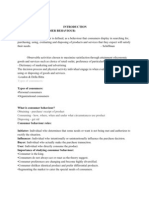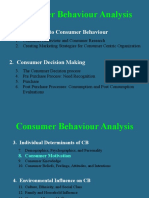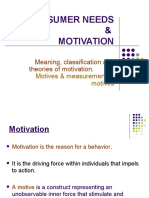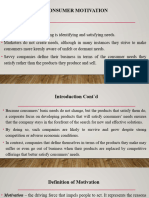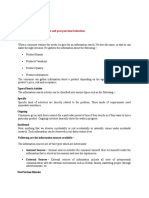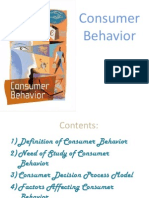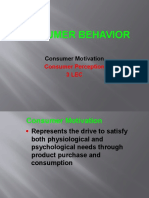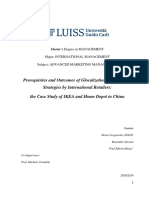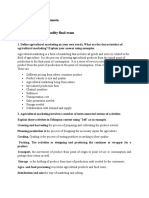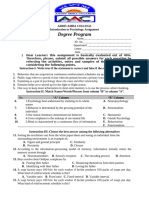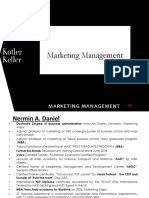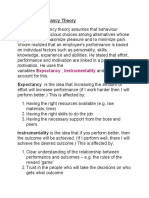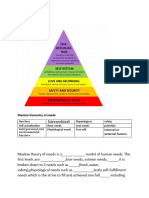0 ratings0% found this document useful (0 votes)
21 viewsCh-2 1
Ch-2 1
Uploaded by
Yeshambel EwunetuThis chapter discusses internal influences on consumer behavior, including motivation and involvement. It defines motivation as the inner drive directing energy towards achieving a goal. Motivation can fulfill utilitarian or hedonic needs and may be influenced by biological, psychological and cultural factors. The chapter also discusses Maslow's hierarchy of needs and McGuire's psychological motives that influence consumer behavior. It describes how different types of needs at varying strength can create approach-approach, approach-avoidance or avoidance-avoidance conflicts for consumers. The chapter concludes by defining involvement as the interest consumers have in the marketplace and describing different types of involvement like enduring, situational, cognitive and affective involvement.
Copyright:
© All Rights Reserved
Available Formats
Download as PDF, TXT or read online from Scribd
Ch-2 1
Ch-2 1
Uploaded by
Yeshambel Ewunetu0 ratings0% found this document useful (0 votes)
21 views41 pagesThis chapter discusses internal influences on consumer behavior, including motivation and involvement. It defines motivation as the inner drive directing energy towards achieving a goal. Motivation can fulfill utilitarian or hedonic needs and may be influenced by biological, psychological and cultural factors. The chapter also discusses Maslow's hierarchy of needs and McGuire's psychological motives that influence consumer behavior. It describes how different types of needs at varying strength can create approach-approach, approach-avoidance or avoidance-avoidance conflicts for consumers. The chapter concludes by defining involvement as the interest consumers have in the marketplace and describing different types of involvement like enduring, situational, cognitive and affective involvement.
Original Title
Ch-2.1
Copyright
© © All Rights Reserved
Available Formats
PDF, TXT or read online from Scribd
Share this document
Did you find this document useful?
Is this content inappropriate?
This chapter discusses internal influences on consumer behavior, including motivation and involvement. It defines motivation as the inner drive directing energy towards achieving a goal. Motivation can fulfill utilitarian or hedonic needs and may be influenced by biological, psychological and cultural factors. The chapter also discusses Maslow's hierarchy of needs and McGuire's psychological motives that influence consumer behavior. It describes how different types of needs at varying strength can create approach-approach, approach-avoidance or avoidance-avoidance conflicts for consumers. The chapter concludes by defining involvement as the interest consumers have in the marketplace and describing different types of involvement like enduring, situational, cognitive and affective involvement.
Copyright:
© All Rights Reserved
Available Formats
Download as PDF, TXT or read online from Scribd
Download as pdf or txt
0 ratings0% found this document useful (0 votes)
21 views41 pagesCh-2 1
Ch-2 1
Uploaded by
Yeshambel EwunetuThis chapter discusses internal influences on consumer behavior, including motivation and involvement. It defines motivation as the inner drive directing energy towards achieving a goal. Motivation can fulfill utilitarian or hedonic needs and may be influenced by biological, psychological and cultural factors. The chapter also discusses Maslow's hierarchy of needs and McGuire's psychological motives that influence consumer behavior. It describes how different types of needs at varying strength can create approach-approach, approach-avoidance or avoidance-avoidance conflicts for consumers. The chapter concludes by defining involvement as the interest consumers have in the marketplace and describing different types of involvement like enduring, situational, cognitive and affective involvement.
Copyright:
© All Rights Reserved
Available Formats
Download as PDF, TXT or read online from Scribd
Download as pdf or txt
You are on page 1of 41
CHAPTER 2
INTERNAL INFLUENCES ON CB
2.1 Motivation and Involvement
MOTIVATION AND INVOLVEMENT
Motivation is defined as “an inner state of
arousal,” with the aroused energy directed to
achieving a goal
Motivation is the reason for behavior. A
motive is a construct representing an
unobservable inner force that stimulates and
compels a behavioral response and provides
specific direction to that response.
CONT’D
Motivation refers to the processes that cause
people to behave as they do. From a psychological
perspective motivation occurs when a need is
aroused that the consumer wishes to satisfy.
Once a need has been activated, a state of
tension exists that drives the consumer to
attempt to reduce or eliminate the need. This
need may be utilitarian or it may be hedonic.
CONT’D
Whether the need is utilitarian or hedonic, a
discrepancy exists between the consumer’s
present state and some ideal state. This gulf
creates a state of tension.
Marketers try to create products and services
that will provide the desired benefits and permit
the consumer to reduce this tension.
CONT’D
The magnitude of this tension determines the
urgency the consumer feels to reduce the tension.
This degree of arousal is called a drive. A basic
need can be satisfied in any number of ways.
Personal and cultural factors combine to create a
want, which is one manifestation of a need.
MOTIVATIONAL STRENGTH AND
DIRECTION
Motivation can be described in terms of its
strength, or the pull it exerts on the consumer,
and its direction, or the particular way the
consumer attempts to reduce motivational
tension.
TYPES OF NEEDS
Biogenic Needs - necessary to maintain life,
such as food, water, air and shelter
Psychogenic needs - the need for status,
power, affiliation, and so on. Psychogenic needs
reflect the priorities of a culture, and their effect
on behavior will vary in different environments.
CONT’D
Utilitarian needs- to get some practical
benefits. -- emphasize the objective, tangible
attributes of products such as fuel economy in a
car
Hedonic needs- are subjective and experiential.
Here, consumers might rely on a product to meet
their needs for excitement, self-confidence,
fantasy, and so on
CHARACTERISTICS OF NEEDS
Each of the preceding needs has several
characteristics:
Needs are dynamic. Needs are never fully
satisfied; satisfaction is only temporary. Also, as
soon as one need is satisfied, new needs emerge.
Needs exist in a hierarchy. Although several
needs may be activated at any one time, some
assume more importance than others.
CONT’D
Needs can be internally or externally
aroused. Although many needs are internally
activated, some needs can be externally cued.
Smelling pizza cooking in the apartment next
door may, for example, affect your perceived need
for food.
Needs can conflict. With the many motives
consumers have, there are frequent conflicts
between motives. Some of the conflicts are
considered below.
MOTIVATIONAL CONFLICTS
A goal has valence, which means that it can be
positive or negative. Consumers are motivated to
approach a positively valued goal and will seek out
products that will help them to reach it.
On the other hand, consumers may instead be
motivated to avoid a negative outcome. They will try
to reduce the chances of attaining this end result.
There are three general types of conflicts can occur:
approach–approach; approach–avoidance and
avoidance–avoidance.
APPROACH–APPROACH CONflICT
In an approach–approach conflict, a person must
choose between two desirable alternatives. A student
might be torn between going home for the holidays or
going on a skiing trip with friends.
APPROACH–AVOIDANCE CONflICT
When we desire a goal but wish to avoid it at the same
time, an approach–avoidance conflict exists. In
this, the consumer is faced both by positive and
negative consequences in the purchase of a particular
products. If one likes chocolates and is diabetic. This
conflict can be solved by taking sugar free chocolate
resolve the conflict.
AVOIDANCE–AVOIDANCE CONflICT
They may face a choice with two undesirable
alternatives, for instance the option of either
throwing more money into an old car or buying a
new one. Marketers frequently address an
avoidance-avoidance conflict with messages that
stress the unforeseen benefits of choosing one
option (e.g. by emphasizing special credit plans to
ease the pain of new car payments).
SPECIfiC NEEDS AND BUYING BEHAVIOR
Other motivational approaches have focused on
specific needs and their ramifications for behavior
Need for achievement refers to the desire to
accomplish something. Sometimes people will express
a need for achievement with premium products that
express success. Eg. Luxury brands
Need for affiliation is the desire to be with other
people. Products that express emotion and aid in group
activities are relevant. Eg. Alcoholic beverages, Sports,
etc.
CONT’D
Need for power is the need to control one’s
environment. Products that allow us to feel
mastery over our surroundings and situation
meet this need. Eg car, luxury resorts, etc.
Need for uniqueness is the need to assert one’s
individual identity. Products that pledge to
illustrate our distinct qualities meet this need.eg.
Perfumes, clothing
MASLOW’S HIERARCHY OF NEEDS
IMPLICATION TO MARKETERS
1. Physiological: Food, water, sleep, and, to an
extent, sex, are physiological motives.
Products
Health foods, medicines, sports drinks, low-
cholesterol foods, and exercise equipment
2. Safety: Seeking physical safety and security,
stability, familiar surroundings, and so forth are
manifestations
Products
Smoke detectors, preventive medicines, insurance,
retirement investments, seat belts, burglar
alarms, and sunscreen.
CONT’D
3. Belongingness: Belongingness motives are
reflected in a desire for love, friendship,
affiliation, and group acceptance.
Products:- Personal grooming, foods,
entertainment, clothing, and many others
4. Esteem: Desires for status, superiority, self-
respect, and prestige are examples of esteem
needs. These needs relate to the individual’s
feelings of usefulness and accomplishment.
Products:- Clothing, furniture, liquors, hobbies,
stores, cars, and many others.
CONT’D
5. Self-Actualization: This involves the desire for
self-fulfi llment, to become all that one is capable
of becoming.
Products
Education, hobbies, sports, some vacations,
gourmet foods, museums.
MCGUIRE’S PSYCHOLOGICAL MOTIVES
McGuire developed a classification system that organizes
these various theories into 16 categories.
Need for Consistency- People try to buy things
which are consistent with their liking and taste
Need for Attribution-We often attribute the cause of
a favorable or unfavorable outcome to ourselves or, to
some outside element
Need to Categorize - objects are categorized in a
number of ways
Need for Objectification - These motives reflect
needs for observable cues or symbols that enable
people to infer what they feel and know
CONT’D
Need for Autonomy -Consumers like to own
products which give them a feeling of independence
Need for Stimulation - People often seek variety and
difference out of a need for stimulation
Teleological Need - Consumers are pattern matchers
who have images of desired outcomes or end states
with which they compare their current situation.
Utilitarian Need - to achieve some practical benefit
such as durability, economy, warmth that define
product performance.
CONT’D
Need for Tension Reduction-Recreational
products and activities are often promoted in
terms of tension relief.
Need for Expression - We want to identify
ourselves and go in for products that let others
know about us
Need for Ego Defense - When our identity is
threatened or when we need to project a proper
image, we use products in our defense
Need for Reinforcement-When we buy a
product which is appreciated by others, it
reinforces our views, our behaviour
CONT’D
Need for Assertion -These needs are fulfilled by
engaging in those kind of activities that bring
self-esteem and esteem in the eyes of others.
Need for Affiliation -We like to use product
which are used by those whom we get affiliated to
Need for Identification -The need for
identification results in the consumer’s playing
various roles.
Need for Modeling - to copy our heroes and our
parents and those we admire
CONSUMER INVOLVEMENT
Involvement is the intensity of interest with
which consumers approach their dealings in the
market place.
Involvement is a motivational state caused by
consumer perceptions that a product, brand, or
advertisement is relevant or interesting
Needs play a strong role in determining what is
relevant or interesting to consumers
TYPES OF INVOLVEMENT
Felt involvement can be (1) enduring, (2)
situational, (3) cognitive, or (4) affective.
Enduring involvement exists when we show
interest in an offering or activity over a long
period of time. Car enthusiasts are intrinsically
interested in cars and exhibit enduring
involvement in them.
CONT’D
Situational involvement - Temporary interest
in an offering, activity, or decision, often caused
by situational circumstances.
Cognitive involvement - Interest in thinking
about and learning information pertinent to an
offering, activity, or decisions.
Affective involvement - Interest in expending
emotional energy and evoking deep feelings
about an offering, activity, or decision.
CONCEPTUALIZING COMPONENTS OF
INVOLVEMENT
LEVELS OF INVOLVEMENT: FROM
INERTIA TO PASSION
A person’s degree of involvement is a continuum that
ranges from absolute lack of interest in a marketing
stimulus at one end to obsession at the other end.
Inertia is consumption at the low end of involvement;
decisions made out of habit (lack of motivation)
At the high end of involvement, we can expect to
find the type of passionate intensity reserved for
people and objects that carry great meaning for the
individual.
INVOLVEMENT DECISIONS
Routinized response behavior or least
involvement. In routinized response, we buy things
as a routine. These are products of daily use which
keep buying almost every now and then.
Low Involvement Decision: These are decision in
which some involvement is necessary. These are
higher value products and involve certain amount of
risk. These products are not bought everyday. These
can be like refrigerators, T.V., Sofa Sets, Computers.
CONT’D
High Involvement Decision Making: These
decisions are very important as these products
are of very high value and involve a lot of risk
and are bought once in a life time or a few times
in a life time. These can a house or an expensive
car.
CONT’D
There are actually several broad types of
involvement related to the product, the message,
or the perceiver.
Product involvement is related to a consumer’s
level of interest in a particular product. Many
sales promotions are designed to increase this
type of involvement.
Message–response involvement (also known
as advertising involvement), refers to the
consumer’s interest in processing marketing
communications
CONT’D
Purchase situation involvement refers to
differences that may occur when buying the same
object for different contexts
Ego involvement (sometimes described as
enduring involvement) refers to the importance
of a product to a consumer’s self-concept. This
concept implies a high level of social risk: the
prospect of the product not performing its desired
function may result in embarrassment or damage
to the consumer’s self-concept
CONSUMERS’ VALUES
Values are beliefs that guide what people regard
as important or good.
Products/services = help in attaining value-
related goal
We seek others that share our values/ beliefs
Thus, we tend to be exposed to
information that supports our
beliefs
VALUE
A value can be defined as a belief about some
desirable end-state that transcends specific
situations and guides selection of behavior. Thus,
values are general and different from attitudes
in that they do not apply to specific situations
only. A person’s set of values plays a very
important role in his or her consumption
activities, since many products and services are
purchased because (it is believed) they will help
us to attain a value-related goal.
VALUE SYSTEMS
One perspective on the study of values stresses
that what sets cultures apart is the relative
importance, or ranking, of these universal values.
This set of rankings constitutes a culture’s value
system.
Every culture is characterized by its members’
endorsement of a value system.
CONT’D
It is usually possible to identify a general set of
core values which uniquely define a culture.
These beliefs are taught to us by socialization
agents, including parents, friends and teachers.
Core values: values shared within a culture
Enculturation: learning the beliefs and values
of one’s own culture
Acculturation: learning the value system and
behaviors of another culture
CONT’D
It is suggested that the consumer experience may
generate eight distinct types of consumer value:
Efficiency – referring to all products aimed at
providing various kinds of convenience for the
consumer.
Excellence – addressing situations where the
experience of quality is the prime motivation.
CONT’D
Status – when the consumer pursues success
and engages in impression management and
noticeable consumption.
(Self-)Esteem – situations where the
satisfaction of possessing is in focus, as is the
case with materialism.
Play – the value of having fun in consuming.
CONT’D
Aesthetics – searching for beauty in one’s
consumption of, e.g., designer products, fashion
or art.
Ethics – referring to motivations behind, e.g.,
morally or politically correct consumption
choices.
Spirituality – experiencing magical
transformations or sacredness in the
consumption, as known from devoted collectors.
End of the
Chapter!
You might also like
- Consumer Behavior Buying Having and Being 12th Edition Solomon Solutions Manual DownloadDocument26 pagesConsumer Behavior Buying Having and Being 12th Edition Solomon Solutions Manual DownloadWilliam Thornton100% (27)
- MPO Assignment 1 (02000539)Document13 pagesMPO Assignment 1 (02000539)Aarkash Kannangara0% (1)
- Ahead of the Curve: Using Consumer Psychology to Meet Your Business GoalsFrom EverandAhead of the Curve: Using Consumer Psychology to Meet Your Business GoalsNo ratings yet
- Consumer Behavior Study Material For MBADocument71 pagesConsumer Behavior Study Material For MBAgirikiruba82% (38)
- Building Strong Brands (Review and Analysis of Aaker's Book)From EverandBuilding Strong Brands (Review and Analysis of Aaker's Book)No ratings yet
- Unit 2Document24 pagesUnit 2p00rnimasinghNo ratings yet
- Consumer MotivationDocument9 pagesConsumer MotivationSarah ShaikhNo ratings yet
- Mba - 204 Consumer BehaviorDocument65 pagesMba - 204 Consumer BehaviorSayed FaisalNo ratings yet
- Motivation: Cognitive Motive Focuses On A Person's Needs For Being Oriented Towards The Environment and Achieving A SenseDocument4 pagesMotivation: Cognitive Motive Focuses On A Person's Needs For Being Oriented Towards The Environment and Achieving A SenseUmair Nadeem100% (1)
- Chapter 2Document84 pagesChapter 2Arshad KhanNo ratings yet
- Unit-4 Individual Determinants of Consumer Behavior: Consumer Needs and MotivationDocument15 pagesUnit-4 Individual Determinants of Consumer Behavior: Consumer Needs and MotivationAnkita NeemaNo ratings yet
- MotivationDocument68 pagesMotivationShalin Subba LimbuNo ratings yet
- Consumer BehaviourDocument75 pagesConsumer BehaviourarvrrawatNo ratings yet
- Consumer MotivationDocument32 pagesConsumer MotivationVipulNo ratings yet
- ConsumermotivationDocument43 pagesConsumermotivationBaishali DasNo ratings yet
- Consumer Behaviour in ServicesDocument19 pagesConsumer Behaviour in ServicesStuti Sachdeva100% (1)
- Managerial Economics Chapter 4-Consumer Behavior and Demand AnalysisDocument13 pagesManagerial Economics Chapter 4-Consumer Behavior and Demand AnalysisChristian AlcaparasNo ratings yet
- Consumer Behaviour AnalysisDocument52 pagesConsumer Behaviour AnalysisDeepanshu SaraswatNo ratings yet
- ConsumerDocument14 pagesConsumerSanyam AgarwalNo ratings yet
- Types of ConsumersDocument67 pagesTypes of ConsumersShikha ShuklaNo ratings yet
- CB Research AssignmentDocument9 pagesCB Research AssignmentKanika JainNo ratings yet
- Effects of Personal Factors On CBDocument2 pagesEffects of Personal Factors On CBSarah ShaikhNo ratings yet
- Faraz Ilyas CCIB ASSIGNMENTDocument15 pagesFaraz Ilyas CCIB ASSIGNMENTfarazmilyasNo ratings yet
- Consumer BehaviourDocument89 pagesConsumer BehaviourshashankgowdaNo ratings yet
- Marketing ManagementDocument43 pagesMarketing ManagementBisma KhalidNo ratings yet
- Consumer Needs & Motivation: Meaning, Classification and Theories of MotivationDocument41 pagesConsumer Needs & Motivation: Meaning, Classification and Theories of Motivationbanti022No ratings yet
- Module - 6 Consumer Behavior: Npiel Consumer Behavior Vinod Gupta School of ManagementDocument14 pagesModule - 6 Consumer Behavior: Npiel Consumer Behavior Vinod Gupta School of ManagementVelacheryManNo ratings yet
- CONSUMER BehaviourDocument41 pagesCONSUMER BehaviourBritney PetersNo ratings yet
- Unit-V Consumer Behaviour (CB) : Meaning and SignificanceDocument19 pagesUnit-V Consumer Behaviour (CB) : Meaning and Significancemahatheer mohamedNo ratings yet
- Session 11 PDFDocument43 pagesSession 11 PDFADITI MEHTANo ratings yet
- Meaning of Consumer BehaviourDocument27 pagesMeaning of Consumer BehaviourFredrick JamesNo ratings yet
- Marketing Chapter 5Document50 pagesMarketing Chapter 5luis.ernesto29No ratings yet
- ProjectDocument82 pagesProjectMurugan Agsamy Murugan AgsamyNo ratings yet
- Flashback Notes XI, Unit-5, MKTDocument9 pagesFlashback Notes XI, Unit-5, MKTsumathi04051984No ratings yet
- CH5 MARKETINGhhDocument7 pagesCH5 MARKETINGhhmayankgoylllNo ratings yet
- Consumer Markets and Consumer Buyer BehaviorDocument4 pagesConsumer Markets and Consumer Buyer BehaviorMarites Llanera100% (1)
- Cb-ch-3 Motivation & PersonalityDocument66 pagesCb-ch-3 Motivation & PersonalityTarun Negi100% (1)
- The Motivation ProcessDocument12 pagesThe Motivation ProcessGia Hân PhạmNo ratings yet
- CBMRDocument11 pagesCBMRPanditPranavMishraNo ratings yet
- Consumer Behaviour Session 2Document64 pagesConsumer Behaviour Session 2sairaj.nalavade029No ratings yet
- Consumer Behaviour - Final-ModuleDocument57 pagesConsumer Behaviour - Final-Moduleavinashpandey10102001No ratings yet
- Tourism and Consumer BehaviorDocument27 pagesTourism and Consumer BehaviorChristopher CuvinNo ratings yet
- CONSUMER BEHAVIOUR - NotesDocument13 pagesCONSUMER BEHAVIOUR - NotesGhost RiderNo ratings yet
- CB Assignment 3Document3 pagesCB Assignment 3Ahsan JamalNo ratings yet
- Comsumer Purchase Behaviour Model: NAME - Shivam Chauhan Class - Bba (3Rd) ROLL NO - 2531Document6 pagesComsumer Purchase Behaviour Model: NAME - Shivam Chauhan Class - Bba (3Rd) ROLL NO - 2531Ravish ChandrsNo ratings yet
- Con BehDocument37 pagesCon Behsubroto36No ratings yet
- Sales and DistributionDocument64 pagesSales and DistributionUday Ram Prasad MedaNo ratings yet
- Presented By:-Sherry MBA - 2 SEMDocument40 pagesPresented By:-Sherry MBA - 2 SEMSherry KaushalNo ratings yet
- Chapter 4 - Motivation and ValueDocument30 pagesChapter 4 - Motivation and Valuemalakdhainy254No ratings yet
- Consumer Decision Making ProcessDocument5 pagesConsumer Decision Making Process7hamaniiiNo ratings yet
- Final Review For CBDocument9 pagesFinal Review For CBMinh ThưNo ratings yet
- CB NotesDocument32 pagesCB NotesArun P PrasadNo ratings yet
- 3 Lec CBDocument62 pages3 Lec CBUsama ALiNo ratings yet
- Motives Which Influence Purchasing DecisionsDocument31 pagesMotives Which Influence Purchasing Decisionsayushi gargNo ratings yet
- MM-Module 2Document10 pagesMM-Module 2Badiger DiwakarNo ratings yet
- Conceptual ProfileDocument7 pagesConceptual ProfileAnonymous XHKw2V4WpNo ratings yet
- Consumer Influences and BehaviorDocument6 pagesConsumer Influences and BehaviorgilbertvtaguinesNo ratings yet
- How to Learn Digital Marketing from Scratch and Alone - Volume 06: Marketing Psychology: Understanding Consumer BehaviorFrom EverandHow to Learn Digital Marketing from Scratch and Alone - Volume 06: Marketing Psychology: Understanding Consumer BehaviorNo ratings yet
- Summary, Analysis & Review of Robert Cialdini's Pre-suasion by InstareadFrom EverandSummary, Analysis & Review of Robert Cialdini's Pre-suasion by InstareadNo ratings yet
- Minimalist Budget: Simple Strategies On How To Save More MoneyFrom EverandMinimalist Budget: Simple Strategies On How To Save More MoneyNo ratings yet
- The Conscious Consumerism Movement: Creating Change Through Your PurchasesFrom EverandThe Conscious Consumerism Movement: Creating Change Through Your PurchasesNo ratings yet
- Chapter Eight Promotion DecisionsDocument35 pagesChapter Eight Promotion DecisionsYeshambel EwunetuNo ratings yet
- DevStat8e 15 04Document19 pagesDevStat8e 15 04Yeshambel EwunetuNo ratings yet
- Nonparametric Statistical MethodsDocument110 pagesNonparametric Statistical MethodsYeshambel EwunetuNo ratings yet
- Chapter Six Non Parametric StatisticsDocument54 pagesChapter Six Non Parametric StatisticsYeshambel EwunetuNo ratings yet
- 1.1abcd Resea RCH PropoDocument19 pages1.1abcd Resea RCH PropoYeshambel EwunetuNo ratings yet
- Chapter Three Mean Difference Analysis (T-Test, Analysis of Variance)Document55 pagesChapter Three Mean Difference Analysis (T-Test, Analysis of Variance)Yeshambel EwunetuNo ratings yet
- Quantitative Methods For MarketersDocument41 pagesQuantitative Methods For MarketersYeshambel EwunetuNo ratings yet
- CH 1Document44 pagesCH 1Yeshambel EwunetuNo ratings yet
- Whole Saler and RetailerDocument52 pagesWhole Saler and RetailerYeshambel EwunetuNo ratings yet
- External Influences On Consumer Behavior: HapterDocument51 pagesExternal Influences On Consumer Behavior: HapterYeshambel EwunetuNo ratings yet
- Consumer Decision Making Process and Outcomes: HapterDocument49 pagesConsumer Decision Making Process and Outcomes: HapterYeshambel EwunetuNo ratings yet
- Physical Distribution Chapter 7Document63 pagesPhysical Distribution Chapter 7Yeshambel EwunetuNo ratings yet
- Ch-1 QuantitativeDocument41 pagesCh-1 QuantitativeYeshambel EwunetuNo ratings yet
- TalonNet Lecture Ch2personalityDocument45 pagesTalonNet Lecture Ch2personalityYeshambel EwunetuNo ratings yet
- Bahir Dar University: Book ReviewDocument5 pagesBahir Dar University: Book ReviewYeshambel EwunetuNo ratings yet
- Group Reading Assignments On Marketing 3Document1 pageGroup Reading Assignments On Marketing 3Yeshambel EwunetuNo ratings yet
- Ch-2 5Document36 pagesCh-2 5Yeshambel EwunetuNo ratings yet
- GlocalizationDocument122 pagesGlocalizationYeshambel EwunetuNo ratings yet
- Spearman P ValueDocument9 pagesSpearman P ValueYeshambel EwunetuNo ratings yet
- Agricultural Marketing Systems and Sustainability-Wageningen University and Research 139420 PDFDocument265 pagesAgricultural Marketing Systems and Sustainability-Wageningen University and Research 139420 PDFYeshambel EwunetuNo ratings yet
- Consummer AssignmentDocument9 pagesConsummer AssignmentYeshambel EwunetuNo ratings yet
- Agri Final ExamDocument5 pagesAgri Final ExamYeshambel EwunetuNo ratings yet
- Individual Assignment 1Document3 pagesIndividual Assignment 1Yeshambel EwunetuNo ratings yet
- Rebuilt - Individual Assignment 1Document2 pagesRebuilt - Individual Assignment 1Yeshambel EwunetuNo ratings yet
- Agricultural Marketing Systems and Sustainability-Wageningen University and Research 139420 PDFDocument265 pagesAgricultural Marketing Systems and Sustainability-Wageningen University and Research 139420 PDFYeshambel EwunetuNo ratings yet
- Theories of MotivationDocument9 pagesTheories of MotivationJeffrey ManzanoNo ratings yet
- General Psychology and Life Skills AssignmentDocument2 pagesGeneral Psychology and Life Skills AssignmentGereNo ratings yet
- Leadership and Management 2003Document46 pagesLeadership and Management 2003Ciella Dela Cruz100% (1)
- BUS160 Final ExamDocument23 pagesBUS160 Final ExamMaria NoedinsNo ratings yet
- 1967 Crises in A Developing OrganizationDocument15 pages1967 Crises in A Developing Organizationnilton_bfoNo ratings yet
- Preview PDFDocument69 pagesPreview PDFvijimol vijaya kumarNo ratings yet
- MG For CHED - pdf-1Document8 pagesMG For CHED - pdf-1qw938No ratings yet
- Business Management by Juraz 85712Document53 pagesBusiness Management by Juraz 85712Munavvir PNo ratings yet
- Marketing Management Ch. 1& 2 AAST 2022Document203 pagesMarketing Management Ch. 1& 2 AAST 2022Ahmed Fawzy0% (1)
- Literature ReviewDocument2 pagesLiterature ReviewMohamed AhmedNo ratings yet
- Bản sao ND ÔN BÀI QTH PHAT - HUYENDocument14 pagesBản sao ND ÔN BÀI QTH PHAT - HUYENSong PhátNo ratings yet
- A Synopsis Report ON: Consumer Buying BehaviorDocument19 pagesA Synopsis Report ON: Consumer Buying BehaviorMohmmedKhayyumNo ratings yet
- Humanistic TheoryDocument23 pagesHumanistic TheoryArshiya SharmaNo ratings yet
- Answers For Data ResponseDocument12 pagesAnswers For Data Responsesbang.alahNo ratings yet
- MMPC006Document32 pagesMMPC006210010502041.mgtNo ratings yet
- Management TheoriesDocument19 pagesManagement TheoriesYASH VERMANo ratings yet
- Addis Ababa University College of Business and EconomicsDocument65 pagesAddis Ababa University College of Business and EconomicsTsion Abera50% (2)
- Paper1 FDN MCQ 2008Document108 pagesPaper1 FDN MCQ 2008Jana PlusNo ratings yet
- Humanistic Approach ActivitiesDocument3 pagesHumanistic Approach ActivitiesAttique IftikharNo ratings yet
- Towards Being HumanDocument12 pagesTowards Being HumanJaymar Magtibay100% (1)
- SS3 Culmination: The Best of MEDocument34 pagesSS3 Culmination: The Best of MEMartine Andrei Macado SabandoNo ratings yet
- HRM Week 5-8Document83 pagesHRM Week 5-8dennisemonreal00No ratings yet
- HappinessDocument85 pagesHappinessaharish_iitkNo ratings yet
- Mindfulness y Autocompasión Musicos 2Document107 pagesMindfulness y Autocompasión Musicos 2jaznarNo ratings yet
- Buying Motives & Theories of Selling: Presented By: Navya Tandon (190677) Sarika Nangia (200004) Tinisha Chhabra (200003)Document56 pagesBuying Motives & Theories of Selling: Presented By: Navya Tandon (190677) Sarika Nangia (200004) Tinisha Chhabra (200003)NAVYA TANDON 190677No ratings yet
- Abraham MaslowDocument5 pagesAbraham MaslowCheasca AbellarNo ratings yet
- Consumer Purchasing DecisionsDocument5 pagesConsumer Purchasing DecisionsLuisa Valencia100% (1)
- Mind Mapping Software Literature ReviewDocument6 pagesMind Mapping Software Literature Reviewafmzbufoeifoof100% (1)
- Revised 8-13 ICM PPT Printed LGDocument255 pagesRevised 8-13 ICM PPT Printed LGRaiNo ratings yet












